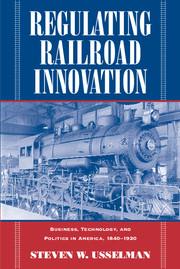Book contents
- Frontmatter
- Contents
- List of Illustrations
- Preface and Acknowledgments
- Introduction
- Part I ASSEMBLING THE MACHINE, 1840–1876
- 1 Engines of Expansion and Extraction: The Politics of Development
- 2 Acquiring Technology: Insider Innovation
- 3 Patent Problems: Inventors and the Market for Technology
- Part II RUNNING THE MACHINE, 1876–1904
- Part III FRICTION IN THE MACHINE, 1904–1920
- Epilogue: The Enduring Challenge of Innovation
- Index
3 - Patent Problems: Inventors and the Market for Technology
from Part I - ASSEMBLING THE MACHINE, 1840–1876
Published online by Cambridge University Press: 12 August 2009
- Frontmatter
- Contents
- List of Illustrations
- Preface and Acknowledgments
- Introduction
- Part I ASSEMBLING THE MACHINE, 1840–1876
- 1 Engines of Expansion and Extraction: The Politics of Development
- 2 Acquiring Technology: Insider Innovation
- 3 Patent Problems: Inventors and the Market for Technology
- Part II RUNNING THE MACHINE, 1876–1904
- Part III FRICTION IN THE MACHINE, 1904–1920
- Epilogue: The Enduring Challenge of Innovation
- Index
Summary
Nearly four decades before the first steam railroad operated in the United States, the Revolutionary generation of political leaders established a mechanism intended to stimulate the creation and diffusion of new technology. At Philadelphia, they incorporated into the Constitution a clause stipulating that the federal government should encourage “science and the useful arts.” The patent clause, as it has since been known, struck an uneasy compromise between competing philosophies of political economy. In endowing the central government with authority to grant monopolies, it preserved a touch of mercantilism in what was rapidly becoming a Smithian world. Thomas Jefferson, an inventor of no small accomplishment, was among the many who looked with suspicion upon such an exercise of government power. When as Secretary of State he took responsibility for first administering the system, Jefferson held inventors to such high standards of novelty and utility that only three received patents during the first year. Yet even the most ardent watchdogs of centralized power could console themselves in knowing that the ultimate test of patented technologies would come not in the halls of government but in the marketplace and the courts. For a patent in and of itself conveyed no rewards or special privileges. Inventors did not receive a bounty based on the perceived utility of their handiwork. Rather, a patent merely extended to creative individuals a legal claim upon those who wished to use their novelties. The market would determine the number of takers and the amount they were willing to pay.
- Type
- Chapter
- Information
- Regulating Railroad InnovationBusiness, Technology, and Politics in America, 1840–1920, pp. 97 - 140Publisher: Cambridge University PressPrint publication year: 2002



